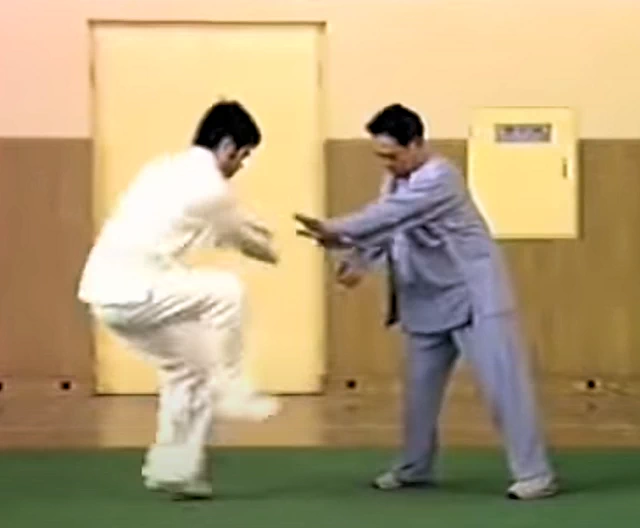From the June 2019 edition of our free Tai Chi newsletter.
Hopping around in Tai Chi class makes us all look foolish. Let’s acknowledge that upfront.
It almost seems like a confidence trick, doesn’t it? The teacher pushes one of their students backwards, and the student responds by jumping upwards, perhaps even bouncing two or three times as they retreat. It must be some kind of gimmick, outsiders say. A practical illusion, designed to make the teacher look strong…right? No other explanation makes sense…
Not yet, anyway. So let me help you make sense of it. Because, in fact, there are very good reasons for hopping around this way.
Pushing is a core element of the Taijiquan curriculum. Pushing is a safer, gentler and subtler alternative to hitting your practice partners. Even still, there are certain inherent risks associated with this practice—especially when pushing fast and hard.
Bumping your head is a risk. Which could happen if you fall down, and strike your head on the ground. Or by stumbling headfirst into a wall, or an innocent bystander. Yikes! We certainly don’t want to slam our heads into solid objects. We also need to avoid FOOSH*, and banging our elbows or knees.
How does the modern Tai Chi community manage these risks? Generally, by avoiding any pushes altogether. Instead, they focus almost exclusively on yielding and evasion. But this creates a negative feedback loop. Students in these schools tend not to develop any offensive skill. And their defensive abilities wither in the absence of any real challenge. When proper training is neglected, the meaning and essence of Taijiquan is lost.
Earlier generations understood that pushing cannot be ignored. Some masters would demonstrate proper technique by launching their disciples into a mattress propped against a wall, again and again, dozens of times in each class. Others taught their students to hop.
Pushing Drills and Pushing Hands
The traditional partner curriculum of Taijiquan goes beyond ding bu tuishou (“fixed-step pushing hands”), to incorporate both simpler and more complicated methods of practice. It includes many limited-scope drills to develop a single attribute—such as the ability to push, or to fa jin (issue force).
The goal of a practice drill is fast, focused improvement. In the case of a pushing drill, we assist our practice partners by offering them a solid and stable mass to push on. To perform this drill, we must temporarily put aside any notions of avoiding or yielding to force, no matter how important these ideas may be in broader contexts.
Forget about stepping backwards or sideways. Restrain any urge to bob and weave, slip and dodge, sink and dissolve. This is not an evasion or a footwork drill; this is a pushing drill.
As we are pushed, we need to minimize the chance of an accidental bump or fall. We accomplish this by remaining upright. That is, by keeping our head above our shoulders, and our shoulders above our feet. But how? There are a few possible approaches.
Our first option is to slide backwards along the ground, like a stick of butter across a hot frying pan. This solution can work… for a perfectly aimed horizontal push… with a level, smooth and flat surface behind you… and if you are wearing low-traction footwear.
Yes, if you happen to be wearing socks on a polished gymnasium floor, then maybe you’ll be safe to slide around this way. Maybe. But in any other circumstance, you’re definitely going to tip over, and crash.
Trying to step out is another bad idea. You cannot step away from a well-timed, explosive, penetrating force. It is not feasible; it is contrary to the purpose of the drill; and the attempt carries significant risk of a standing knee or ankle strain.
As it turns out, there is really only one good option for this pushing drill. That is to jump.
与人对敌之际,偶处下风,在所难免。设遇此境地,心中不可慌忙,既被打中,避已不及之时,须效麻雀跳跃,双足一齐离地,整个跳出,方不致跌倒。跳出以后,身形不散,心神不乱,敌如继续进攻,我可从容应付。
【被打欲跌须雀跃】 From “Methods of Applying Taiji Boxing” (太极拳使用法) by Dong Huling 董虎岭 (1956).
When facing an opponent, it is inevitable that you will occasionally be at a disadvantage. If you encounter this situation, you should not panic. Once hit and unable to avoid it, you must imitate the sparrow’s hop, lift both feet off the ground, and jump out completely. This way you avoid falling. After jumping away, my body remains intact and my mind is relaxed. If the opponent continues to attack, I can deal with it calmly.
Don’t Stop the Hop
Hopping allows your body to move quickly across the floor, dissipating force while remaining vertical. It allows you to practice elements of Tai Chi with real speed and power, and with minimal risk of collision or injury.
Hopping, it turns out, is not foolish after all. Within its original intended context, it is a brilliant solution.
This is why legitimate Tai Chi instructors have been teaching their students** to hop for decades—long before outsiders started watching practice drills, overlooking essential context, and then attempting to explain them to other outsiders on social media. They don’t understand what they are seeing…but now you do!
—
Chris Marshall
Head Instructor
Shoreline Tai Chi
* FOOSH = Falling Onto an Out-Stretched Hand; a common class of injury
** See demonstrations by Cui Yishi 崔毅士, Dong Huling 董虎岭, Feng Zhiqiang 冯志强, Fu Zhongwen 傅钟文, Zheng Manqing (郑曼青) and many others.
